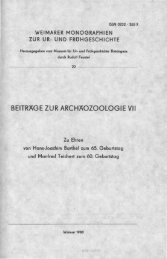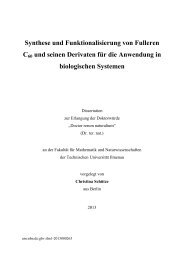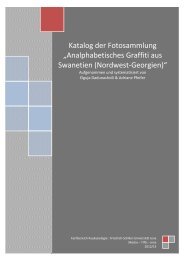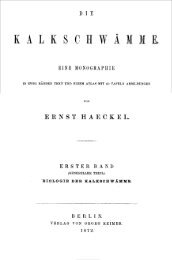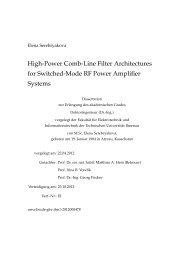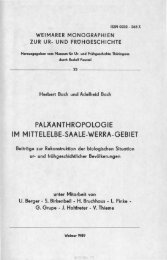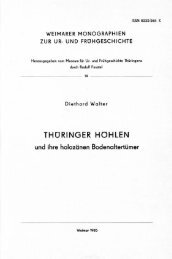Dissertation
Dissertation
Dissertation
You also want an ePaper? Increase the reach of your titles
YUMPU automatically turns print PDFs into web optimized ePapers that Google loves.
|1.9 Multicomponent Systems from Fundamental Building Blocks|<br />
reaction (ET) which leads to the formation of the groundstate sensitizer in an oxidized (oxidative<br />
quenching) or reduced form (reductive quenching). These redox reaction involving quenching<br />
mechanisms lead to the formation of charge pairs and, hence, represent a particularly important<br />
step toward long term charge separation.<br />
In accordance to the HOMO-LUMO 1 MLCT-absorption, also ground state redox chemistry<br />
typically involves the metal centered HOMO and the LUMO which is localized on the ligand.<br />
Hence, electrochemical GS-oxidation of [Ru(bpy) 3 ] 2+ -type complexes takes place at the metal<br />
fragment with simultaneous formation of a complex with π M (t 2g ) 5 -configuration (compare<br />
figure 19). Whereas GS-reduction takes place at a ligand centered orbital with retention of the<br />
π M (t 2g ) 6 -configuration of the metal fragment. [40] The oxidation and reduction potential of the<br />
ground state ions (-1.28 and +1.26 V in water vs. NHE) are stronger than that of the excited<br />
biradical species and may also be used to oxidize or reduce water.<br />
It is important that these processes are quasi reversible so that a reductively or oxidatively<br />
quenched chromophore can be regenerated without decomposition (requirement 1). This<br />
regeneration of the Ru(II) chromophore by a second component S may complete the hypothetical<br />
light-driven catalytic electron transfer cycle (excitation, quenching, regeneration), e.g. in the<br />
photoreduction of water.<br />
It follows that *[Ru(bpy) 3 ] 2+ is at the same time a fairly good energy donor, electron acceptor,<br />
and electron donor. [36] Whereas the potentials of charged quenching products are very high<br />
and are definitely sufficient to oxidize or reduce water respectively. Although its excited state<br />
*[Ru(bipy) 3 ] 2+ is thermodynamically capable of both oxidizing and reducing water at neutral pH,<br />
this has not been found to occur.<br />
1.9.2 Redox Systems for Charge Separation<br />
As described before, light excitation increases both the oxidizing and the reducing power of a<br />
chromophore. Therefore, light excitation of P can often be utilized by subsequent electron transfer<br />
(ET) processes. Unfortunately, a direct oxidation or reduction of water by *[Ru(bipy) 3 ] 2+ -type<br />
complexes has not been found to occur. Thus, suitable redox mediators R have to account for the<br />
fast and irreversible charge separation via quenching mechanisms to gather or deliver electrons<br />
from or to the chromophore. Furthermore, such redox ferries have the function to mediate the<br />
|29|



